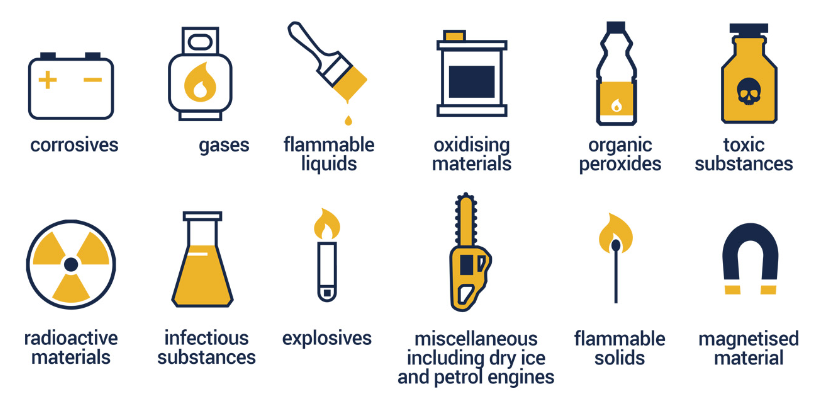What are Dangerous Goods?
Dangerous Goods, or Hazardous Materials, are solids, liquids, gases, articles or manufactured products which can harm people, animals, other living organisms, property or the environment.
Dangerous goods are transported across, in and out of the Falkland Island by air on a regular basis – this is because, although classed as ‘dangerous’ or ‘hazardous’, most of the goods in question are things that are used for necessary everyday activities. These include aerosols, paints, chemicals, adhesives, batteries, survival equipment and compressed gases.

There are Regulations* in place to ensure that any dangerous goods are carried in the safest way possible, and these regulations are enforceable by the Falkland Islands Civil Aviation Department. The regulations apply to national and international aviation, so in the case of the Falkland Islands this means all mail, freight, cargo and luggage that is flown around the Islands by FIGAS, and into and out of the Islands on the LATAM flight or the South Atlantic Airbridge.
*The Regulations in force in the Falkland Islands include:
- The Air Navigation (Overseas Territories) Order 2013, as amended
- ICAO Annex 18 – The Safe Transport of Dangerous Goods by Air
- ICAO Doc 9284 – The Technical Instructions for the Safe Transport of Dangerous Goods by Air
- OTAR Part 92 – Carriage of Dangerous Goods
Mail – The Falklands Post Services do not accept any dangerous goods in the mail for transport by air. This applies to all airmail, ‘surface’ mail and mail/freight intended to be carried by FIGAS.
If you are unsure whether your airmail package contains dangerous goods please contact FPS and they will be able to advise you further.
Hold and Hand Luggage – As with mail, the general rule is that dangerous goods should not be carried in hold or hand luggage, however exceptions have been made to allow passengers to carry certain items. These items include: spare lithium batteries, either contained in packaging or packed in a way that prevents any accidental activation; e-cigarettes; aerosols and alcohols as personal toiletries (deodorant, perfume, etc); portable electronic devices containing lithium batteries (laptops, smart phones, tablets, etc); and alcoholic beverages. Items such as cigarette lighters and safety matches are permitted but must be carried on the person rather than in hand or hold luggage.
If you are unsure about what you may or may not carry in your hand or hold luggage you can contact the airline or visit their website for more information.
Cargo & Freight – The majority of the rules regarding dangerous goods are made in reference to these items being carried as freight and cargo. The risk that comes with the transport of dangerous goods is mitigated and minimised as much as possible by ensuring that each item is packaged in such a way as to prevent any accidental spillage, leakage, breakage etc. It is important to pack dangerous goods in accordance with the regulations, and those packages then have hazard labels affixed to them so that they are instantly identifiable in the cargo hold of an aircraft.
If you wish to send something as cargo/freight by air and are unsure whether it is classed as dangerous goods you can contact the airline or freight forwarder and they will be able to advise you further.
